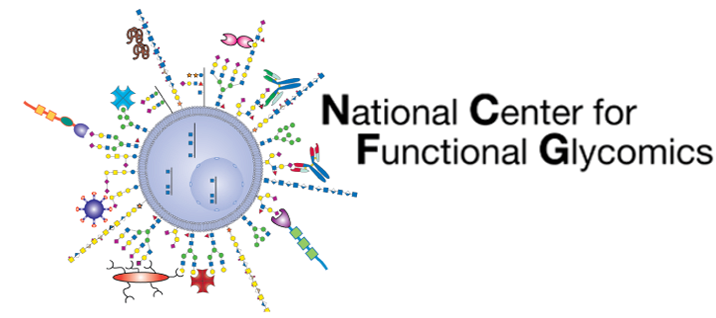By: Richard D. Cummings
The major urinary glycoprotein is the Tamm-Horsfall protein (THP), also named uromodulin (Umod), and encoded by UMOD (1-4). Its concentration in urine can be as high as 1-2 mg/mL. It was discovered in 1950 by Tamm and Horsfall in their studies on compounds in urine that could inhibit viral agglutination of red blood cells (5). THP is synthesized as a GPI-anchored glycoprotein with 8 known N-glycosylation sites (6), and has a subunit size of ~95kDa; however, its oligomeric size is ~1 million Da. THP is synthesized by one exclusive source – the renal tubular cells of the distal loop of Henle; proteolysis results in its release from membranes and into urine. THP in urine can exist in relatively long polymeric forms as well as less oligomeric forms (7).
Carbohydrate constitutes ~25-30% of its weight (8). Hundreds of different N-glycans have been identified on purified THP, including oligomannose and complex, sialylated and fucosylated bi-, tri-, and tetraantennary glycans; many of the latter contain unusual modifications, e.g., non-reducing lacdiNAc modification GalNAcβ1-4GlcNAcβ-R, and the Sda-determinant GalNAcβ1-4(Neu5Acα2-3)Galβ1-4-R (9,10). THP in the urine of pregnant donors has a variety of O-glycans with core 2-based sequences, and high expression of the sialyl Lewis x (SLex) antigen, whereas THP from non-pregnant donors and males is enriched in core 1 O-glycans and lacks SLex (11).
Interestingly, THP is a major example of sex-dependent differences in protein glycosylation (12). THP from female donors tends to have an increased proportion of oligomannose type N-glycans and non-fucosylated glycans, compared to male donors, which tend to have an increased proportion of fucosylated complex-type glycans. Thus, the glycosylation of THP/uromodulin is hormonally influenced.
Mutations in UMOD are associated with multiple types of kidney diseases, e.g., acute kidney injury, chronic kidney disease and autosomal-dominant tubulointerstitial kidney disease (7). This is becoming a major area of research as the mechanisms of THP functions in that regard are unclear. THP has a major role as an innate immune protein, limiting urinary tract infections (UTIs), as genetic deletion of the gene encoding THP in mice (THP-/- mice) makes them more experimentally sensitive to infection upon inoculation with type 1 fimbriated E. coli (13,14). It might also function, as identified originally by Tamm and Horsfall, as an inhibitor of viral infections. The functions of the THP glycans may be to partly restrict colonization of the urinary tract by bacteria, as the glycans of THP can be bound by type 1 fimbriated E. coli, likely through the E. coli FimH lectin (15), which could lead to competitive inhibition of colonization. In addition, THP has key roles in regulating salt/water transport, kidney stone formation, and other renal functions, and helps to control renal homeostasis (16).
References
1. Weichhart, T., Zlabinger, G. J., and Saemann, M. D. (2005) The multiple functions of Tamm-Horsfall protein in human health and disease: a mystery clears up. Wien Klin Wochenschr 117, 316-322
2. Serafini-Cessi, F., Malagolini, N., and Cavallone, D. (2003) Tamm-Horsfall glycoprotein: biology and clinical relevance. Am J Kidney Dis 42, 658-676
3. Wu, T. H., Li, K. J., Yu, C. L., and Tsai, C. Y. (2018) Tamm-Horsfall Protein is a Potent Immunomodulatory Molecule and a Disease Biomarker in the Urinary System. Molecules 23
4. Micanovic, R., LaFavers, K., Garimella, P. S., Wu, X. R., and El-Achkar, T. M. (2020) Uromodulin (Tamm-Horsfall protein): guardian of urinary and systemic homeostasis. Nephrol Dial Transplant 35, 33-43
5. Tamm, I., and Horsfall, F. L., Jr. (1952) A mucoprotein derived from human urine which reacts with influenza, mumps, and Newcastle disease viruses. J Exp Med 95, 71-97
6. Weiss, G. L., Stanisich, J. J., Sauer, M. M., Lin, C. W., Eras, J., Zyla, D. S., Truck, J., Devuyst, O., Aebi, M., Pilhofer, M., and Glockshuber, R. (2020) Architecture and function of human uromodulin filaments in urinary tract infections. Science 369, 1005-1010
7. Nanamatsu, A., de Araujo, L., LaFavers, K. A., and El-Achkar, T. M. (2024) Advances in uromodulin biology and potential clinical applications. Nat Rev Nephrol 20, 806-821
8. Wenk, R. E., Bhagavan, B. S., and Rudert, J. (1981) Tamm-Horsfall uromucoprotein and the pathogenesis of casts, reflux nephropathy, and nephritides. Pathobiol Annu 11, 229-257
9. van Rooijen, J. J., Voskamp, A. F., Kamerling, J. P., and Vliegenthart, J. F. (1999) Glycosylation sites and site-specific glycosylation in human Tamm-Horsfall glycoprotein. Glycobiology 9, 21-30
10. Williams, J., Marshall, R. D., van Halbeek, H., and Vliegenthart, J. F. (1984) Structural analysis of the carbohydrate moieties of human Tamm-Horsfall glycoprotein. Carbohydr Res 134, 141-155
11. Easton, R. L., Patankar, M. S., Clark, G. F., Morris, H. R., and Dell, A. (2000) Pregnancy-associated changes in the glycosylation of tamm-horsfall glycoprotein. Expression of sialyl Lewis(x) sequences on core 2 type O-glycans derived from uromodulin. J Biol Chem 275, 21928-21938
12. Mo, B., Scharf, B., Gutheil, C., Letzel, M. C., and Hensel, A. (2023) Tamm-Horsfall protein in humane urine: sex-dependent differences in the excretion and N-glycosylation pattern. Sci Rep 13, 17815
13. Bates, J. M., Raffi, H. M., Prasadan, K., Mascarenhas, R., Laszik, Z., Maeda, N., Hultgren, S. J., and Kumar, S. (2004) Tamm-Horsfall protein knockout mice are more prone to urinary tract infection: rapid communication. Kidney Int 65, 791-797
14. Mo, L., Zhu, X. H., Huang, H. Y., Shapiro, E., Hasty, D. L., and Wu, X. R. (2004) Ablation of the Tamm-Horsfall protein gene increases susceptibility of mice to bladder colonization by type 1-fimbriated Escherichia coli. Am J Physiol Renal Physiol 286, F795-802
15. Cavallone, D., Malagolini, N., Monti, A., Wu, X. R., and Serafini-Cessi, F. (2004) Variation of high mannose chains of Tamm-Horsfall glycoprotein confers differential binding to type 1-fimbriated Escherichia coli. J Biol Chem 279, 216-222
16. Takata, T., and Isomoto, H. (2024) The Versatile Role of Uromodulin in Renal Homeostasis and Its Relevance in Chronic Kidney Disease. Intern Med 63, 17-23
